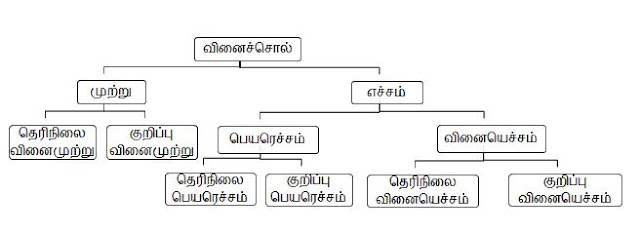Definition: A verb is a word used to describe an action, state or occurrence and forming the main part of the predicate of a sentence.
வரையரை: ஒரு வினைச்சொல் என்பது ஒரு செயல், நிலை அல்லது நிகழ்வை விவரிக்கும்.இது ஒரு வாக்கியத்தின் பயனிலையாக அமைந்து இருதியில் வரும்.
வினைச் சொல்லில், பகுதி (root), விகுதி (suffix) மூவிடம் (three persons), ஐம்பால்(five gender), காலம்(time), ஏவல் (imperative mood), வியங்கோள் (polite imperative), ஈரெச்சம் (வினை எச்சம் – adverbial participles & பெயர் எச்சம் – adjective participles), ஏதிர்மறை (negative), தொழிற்பெயர் (verbal noun), இப்பத்துப்பொருளை அறியவேண்டும்
Usually(not always) from verb we can understand root, suffix, three persons, five gender, time, mood, adverbial participles, adjective participle, indicative or negative and name of work.
The Tamil verb consists of stem + voice suffix + causative suffix + tense-mood marker + aspect marker + person-number marker. Voice, causative and aspect suffixes are optional. Auxiliary verbs are used to form compound tenses and to express attitudes related to the action like antipathy, relief, unhappiness about the result of an event, etc.
பகுதி (root):
வரையரை: பெயர்ப்பகுபதங்களுள்ளும், வினைப்பகுபதங்களுள்ளும், தத்தம் முதனிலை ஆய பகாப்பதங்களே அவற்றின் பகுதி ஆம்.
The root word is the primary lexical unit of a word, and of a word family (this root is then called the base word), which carries the most significant aspects of semantic content and cannot be reduced into smaller constituents.
விகுதி : ஓர் எழுத்தோ அல்லது பல எழுத்தோ சொல்லின் இறுதியில் நின்று சொல்லை உருவாக்கினால் அது விகுதி எனப்படும். திணை, பால், இடம் முதலியவற்றைக் காண்பித்துச், சொல்லின் ஈற்றிலே நிற்கும் உருபே விகுதி.
(எ. கா.) அன், ஆன், ஆர், ஆள், ஈர், ஓம்
The விகுதி is the affix by which the gender, number and person of the verb is distinguished. These affixes are joined to the root after the letters characteristic of the tenses. The verb with these affixes is called முற்றுவினை i.e complete verb as it conveys a complete sense and finishes a sentence These are personal terminations of Verbs. It shows
மூவிடம் (three persons):
தன்மை முன்னிலை படர்க்கை என்ற மூன்று இடங்கள்
1. தன்மை (First person) - தன்னையே குறிக்கும் சொல் ( எ.கா: நான். நான் என்பது யார் சொல்லுகிறாரோ அவரைக் குறிக்கும்.)
• தன்மை இரண்டு வகைப்படும். அவை
1. தன்மை ஒருமை (First person singular) . ( எ.கா : நான் (I) )
2. தன்மை பன்மை (First person plural). ( எ. கா : நாங்கள்(we)
2. முன்னிலை (Second person) - முன் நிற்பவரைக் குறிக்கும்.
( எ.கா : நீ. நீ என்பது நம் எதிரில் நிற்பவரைக் குறிக்கும். )
* முன்னிலை இரண்டு வகைப்படும். அவை,
1. முன்னிலை ஒருமை (Second person singular). ( எ.கா: நீ (you))
2. முன்னிலை பன்மை (Second person plural). ( எ. கா: நீங்கள் (you)
3. படர்க்கை (Third person) - மூன்றாவது ஒரு நபரைக் குறிக்கும். ( எ. கா: அவன் (he), அவை (those), அவர் (honorific form of he)
படர்க்கை இரண்டு வகைப்படும். அவை
1. படர்க்கை ஒருமை (Third-person singular). (எ.கா: அவன் (he), அவள் (she), அவர் (an honorific form of he)
2. படர்க்கை பன்மை (Third person plural). ( எ.கா : அவர்கள் (They), அவை (Those)
ஐம்பால்(five gender)
1. ஆண்பால், masculine singular; ஒருவன் (one man or boy), or அவன் (he)
2. பெண் பால், feminine singular; ஒருத்தி (one girl or lady), or அவள் (she);
3. பலர்பால், masculine or feminine plural;--of the உயர்திணை, or rational class; அவர் (they)
உயர்திணை ை: பகுத்தறிவு கொண்ட மக்களையும் (people), தேவரையும் (devas or celestial persons) நரகரையும் (asuras) குறிப்பது உயர்திணை எனப்படும். Living organism with sixth sense like people, devas or celestial persona and asuras are included in uyarthiNai உயர்திணை
4. ஒன்றன் பால், or ஒருமைப்பால், neuter singular of the அஃறிணை, or irrational class.; ஒன்று (one), or அது (it)
5. பலவின்பால், or பன்மைப்பால், neuter plural --of the அஃறிணை, or irrational class. பல (many), or அவை
Verbs take tense and person-number-gender suffixes. Like some nouns verbs also morphologically deficient i.e. some verbs do not take all the suffixes meant for verbs. The verb is an obligatory part of a sentence except for copula sentences (ex. அவன் மாணவன் - he is a student).
Verbs can be classified into different types based on morphological (the study of the form of words), syntactic (arrangement of words) and semantics (the study of meaning) characteristics.


No comments:
Post a Comment